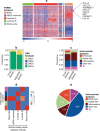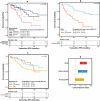Heterocellular gene signatures reveal luminal-A breast cancer heterogeneity and differential therapeutic responses
- PMID: 31396557
- PMCID: PMC6677833
- DOI: 10.1038/s41523-019-0116-8
Heterocellular gene signatures reveal luminal-A breast cancer heterogeneity and differential therapeutic responses
Abstract
Breast cancer is a highly heterogeneous disease. Although differences between intrinsic breast cancer subtypes have been well studied, heterogeneity within each subtype, especially luminal-A cancers, requires further interrogation to personalize disease management. Here, we applied well-characterized and cancer-associated heterocellular signatures representing stem, mesenchymal, stromal, immune, and epithelial cell types to breast cancer. This analysis stratified the luminal-A breast cancer samples into five subtypes with a majority of them enriched for a subtype (stem-like) that has increased stem and stromal cell gene signatures, representing potential luminal progenitor origin. The enrichment of immune checkpoint genes and other immune cell types in two (including stem-like) of the five heterocellular subtypes of luminal-A tumors suggest their potential response to immunotherapy. These immune-enriched subtypes of luminal-A tumors (containing only estrogen receptor positive samples) showed good or intermediate prognosis along with the two other differentiated subtypes as assessed using recurrence-free and distant metastasis-free patient survival outcomes. On the other hand, a partially differentiated subtype of luminal-A breast cancer with transit-amplifying colon-crypt characteristics showed poor prognosis. Furthermore, published luminal-A subtypes associated with specific somatic copy number alterations and mutations shared similar cellular and mutational characteristics to colorectal cancer subtypes where the heterocellular signatures were derived. These heterocellular subtypes reveal transcriptome and cell-type based heterogeneity of luminal-A and other breast cancer subtypes that may be useful for additional understanding of the cancer type and potential patient stratification and personalized medicine.
Keywords: Cancer genomics; Tumour heterogeneity.
Conflict of interest statement
Competing interestsA.S. has ownership interest as a patent inventor for a patent entitled “Colorectal cancer classification with differential prognosis and personalized therapeutic responses” (patent number PCT/IB2013/060416). A.S. has research funding from Bristol-Myers Squibb and Merck KgaA. M.C.U.C. has a patent: US Patent No. 9,631,239 with royalties paid. The rest of the authors declare that there are no competing interests.
Figures






Similar articles
-
Immune gene expression profiling reveals heterogeneity in luminal breast tumors.Breast Cancer Res. 2019 Dec 19;21(1):147. doi: 10.1186/s13058-019-1218-9. Breast Cancer Res. 2019. PMID: 31856876 Free PMC article.
-
Intrinsic subtype and immunity score in identification of triple-negative breast cancer at low risk.Breast. 2025 Apr;80:103889. doi: 10.1016/j.breast.2025.103889. Epub 2025 Jan 23. Breast. 2025. PMID: 39908962 Free PMC article.
-
Analysis of Tumor Microenvironment Heterogeneity among Breast Cancer Subtypes to Identify Subtype-Specific Signatures.Genes (Basel). 2022 Dec 23;14(1):44. doi: 10.3390/genes14010044. Genes (Basel). 2022. PMID: 36672784 Free PMC article.
-
Molecular profiling of breast cancer cell lines defines relevant tumor models and provides a resource for cancer gene discovery.PLoS One. 2009 Jul 3;4(7):e6146. doi: 10.1371/journal.pone.0006146. PLoS One. 2009. PMID: 19582160 Free PMC article.
-
Clinical Implications of Breast Cancer Intrinsic Subtypes.Adv Exp Med Biol. 2025;1464:435-448. doi: 10.1007/978-3-031-70875-6_21. Adv Exp Med Biol. 2025. PMID: 39821037 Review.
Cited by
-
Improving breast cancer care coordination and symptom management by using AI driven predictive toolkits.Breast. 2020 Apr;50:25-29. doi: 10.1016/j.breast.2019.12.006. Epub 2020 Jan 21. Breast. 2020. PMID: 31978814 Free PMC article.
-
Heterogeneity in 2,6-Linked Sialic Acids Potentiates Invasion of Breast Cancer Epithelia.ACS Cent Sci. 2021 Jan 27;7(1):110-125. doi: 10.1021/acscentsci.0c00601. Epub 2021 Jan 4. ACS Cent Sci. 2021. PMID: 33532574 Free PMC article.
-
Decision of Adjuvant Systemic Treatment in HR+ HER2- Early Invasive Breast Cancer: Which Biomarkers Could Help?Cancer Manag Res. 2019 Dec 11;11:10353-10373. doi: 10.2147/CMAR.S221676. eCollection 2019. Cancer Manag Res. 2019. PMID: 31849525 Free PMC article. Review.
-
Patient-derived tumor spheroid cultures as a promising tool to assist personalized therapeutic decisions in breast cancer.Transl Cancer Res. 2022 Jan;11(1):134-147. doi: 10.21037/tcr-21-1577. Transl Cancer Res. 2022. PMID: 35261891 Free PMC article.
-
Identifying prognostic subgroups of luminal-A breast cancer using deep autoencoders and gene expressions.PLoS Comput Biol. 2023 May 30;19(5):e1011197. doi: 10.1371/journal.pcbi.1011197. eCollection 2023 May. PLoS Comput Biol. 2023. PMID: 37253056 Free PMC article.
References
Grants and funding
LinkOut - more resources
Full Text Sources
Other Literature Sources

